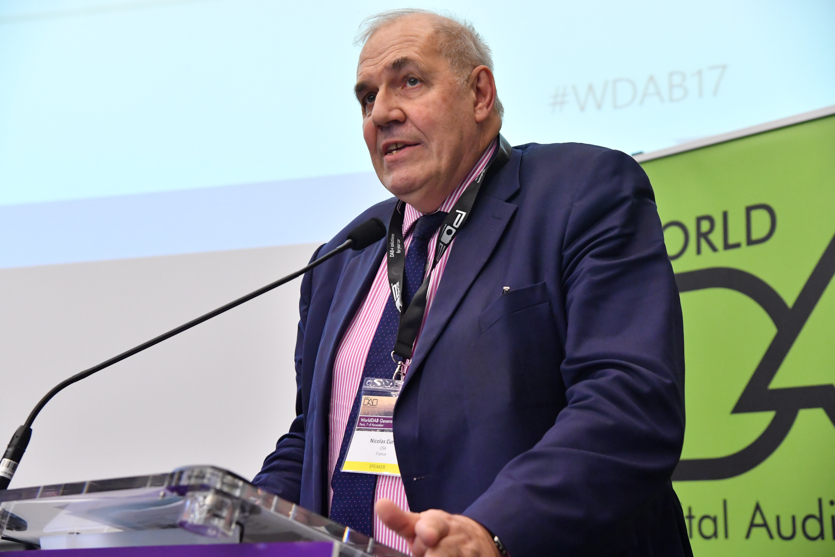DAB+ gets a boost in France: CSA announces a clear and detailed plan
08.01.2018
Just after Christmas French regulator, the CSA, announced its plan for the acceleration of DAB+ rollouts in France. In this blog, Jean-Marc Dubreuil, Country Manager, France, at WorldDAB, explains the key points from the consultation and the CSA’s proposals.

The plan was first announced at the WorldDAB General Assembly in Paris
The new strategy is titled “nodes and arcs”. Metropolitan coverage will be the nodes of the strategy, while highways and main road are the arcs. The plan was shaped throughout 2017, gathering input from the industry, and spoilers were revealed during the WorldDAB General Assembly in November 2017 in Paris.
What can France expect from this ambitious plan? By 2020, the 47 most populated area of France (70%+ of the population) will be covered by a regional DAB+ multiplex and 47% by a local multiplex. If the national call for application is successful, highways and main roads will offer the continuity of radio listening for the drivers from north to south and east to west. By 2021, DAB+ will have brought a significant improvement to the radio industry, giving French radio a chance to compete in the digital age.
Lessons from existing deployments and the consultation
Until this day, the deployment of “RNT” (digital radio in France) was focused on cities and a time table pictured a slow transition, city by city, extending to 2023 or later. Four calls for applications leading to services are already completed (Paris, Nice and Marseille in 2014) or in the process of being completed (Lille, Lyon, Strasbourg, Nantes, Bordeaux, Toulouse). Regional multiplexes were overly subscribed while local ones, mostly in low population areas were seldom requested, endangering the multiplex’s viability. Resource was set aside for a potential national call for applications.
It was clear that, despite the willingness to move forward, carved in a report from late 2015, there was a need to change the landscape to boost DAB+ in France.
As is the practice, the CSA decided in mid 2017 to consult the industry. The outcome of that consultation was published on the 27th of December. These are the key points of that consultation:
- There were 47 responses from 50 companies from the industry, including 37 broadcasters The deployment of DAB+, whether at the local, regional or national level (to cover main roads), is supported by a large majority of contributors
- The public broadcaster is interested in broadcasting all its services on DAB+ if certain conditions are met. National commercial radio remain reluctant to move to DAB+
- Receiver manufacturers expressed the need for visibility of the population coverage that has legal ramification on integration of DAB+ in receivers
- Most insisted on the need to accelerate with 2020 as the target for 80% population coverage
- A critical success factor, beyond population coverage, is the requirement for a marketing campaign aimed at the listeners
- Population coverage should not be the sole objective, highways and main roads should be considered
- Cost could be reduced by a faster deployment and sharing of infrastructure
- Most contributors want to see the national and regional calls for application to happen during the same period of time
New momentum for DAB +: key points from the proposal
It is on these terms that the CSA introduced its so called “arc and nodes” plan. On the basis of the replies to the 2017 consultation, it published new conditions for the calls for applications as well as a new calendar. The publication from the 27th of December is both educational and strategic and sets out the following key points:
- It clearly calls out 2018 as the turning point for DAB+ in France
- The CSA is using DAB+ and not RNT to describe digital radio broadcasting: they want to avoid the confusion with Internet Digital Radio and leverage the DAB+ name used across the world
- The plan goes into the basics and benefits of DAB+,
- It explains the available resources and what will be done at the local, regional and national level
- Typically, the focus will be put on regional and high population density areas (city centres), putting local deployment on the back burner until 2020
- The CSA then explains the timetable:
- July 2018 : 1st calls for application – 15 calls, fully independent, across 15 metropolitan (region) areas with a population greater than 175k
- July 2019, 2nd set of calls for application for another 15 metropolitan areas
- Mid 2018, after a consultation with stakeholders, national call for application for 2 multiplexes (outdoor coverage, for main road and highways)
- The metropolitan coverage will be the nodes of the strategy, while highways and main roads are the arcs.
- The nodes : Toulon, Grenoble, Avignon, Montpellier, Saint-Étienne, Tours, Rennes, Metz, Orléans, Clermont-Ferrand, Dijon, Nancy, Reims, Caen, Le Mans, Bayonne, Angers, Pau, Perpignan, Limoges, Brest, Nîmes, Annecy, Amiens, Chambéry, Annemasse, Besançon, Poitiers, Troyes et La Rochelle (Four calls for application are already completed or in progress)
- The expectation is that first coverage is achieved 15 months after the calls for application enabling the national and regional coverage by the end of 2020
- Finally, the CSA clearly calls out the fact that the 20% threshold for population coverage will be achieved by end of the year 2018, giving visibility for receiver manufacturers with regards to the obligation to integrate DAB+ in their receivers
Posted in:

